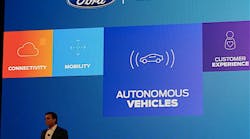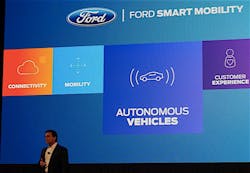In 1913, Ford implemented the first moving assembly line for automobiles, building its Model T automobile in a little over two and a half hours. Their success was seen as a milestone for creating thousands of assembly-worker jobs, changing the conduction of car manufacturing in the U.S., and extending the use of cars to the middle class.
This week, Ford Motor Company officially set the deadline to make its next contribution to automobile manufacturing. The automaker promised to mass produce fully automated vehicles by 2021. Its design will not include a steering wheel, gas pedals, and any other features that accommodate human drivers, according to Mark Fields, the chief executive of Ford. Ford expects that the cars will be used for ride-share and commercial mobility purposes.
To follow through on that goal, Ford is also building up its Silicon Valley R&D team. The company said that it will add two more buildings across the street from its Research and Innovation center and nearly double its staff working on self-driving cars. Engineers, technologists, designers, and other workers will design more efficient sensors, AI frameworks, and systems so that the next generation of cars will be affordable to mass produce.
Ford is also investing in several companies and partnerships, including one with Light-Detection and Ranging (LIDAR) sensor developer, Velodyne. It also announced plans to acquire SAIPS, an Israeli startup that develops frameworks for machine learning and AI. This acquisition will build up Ford’s expertise in video processing, proximity sensing, and deep-learning neural networks—a subset of machine learning where computers store various responses to ambiguous inputs like images, and then weigh the value of these outputs to choose the best response to a specific situation.
Ford also is forming a licensing agreement with Nirenberg Neuroscience, which was founded by a neuroscientist that decoded neural signals for transferring visual information to the brain. She incorporated this neural code into software for prosthetic eyes, and plans to help Ford incorporate these into a visual processor for its cars. Finally, Ford chooses to invest in Civil Maps to create and 3D maps of its surroundings.


